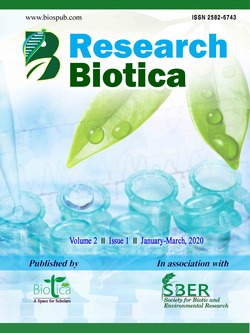
Integrated Crop-Livestock Farming Systems: A Strategy for Dry Land and Conservation Agriculture
Chandan Singh Ahirwar*
School of Agriculture, ITM University, Gwalior, Madhya Pradesh (474 001), India
Ravindra Nath
School of Agriculture, ITM University, Gwalior, Madhya Pradesh (474 001), India
DOI: https://doi.org/10.54083/ResBio.2.1.2020.11-14
Keywords: Conservation agriculture, Crop-Livestock farming, Integrated farming systems, Rainfed farming
Abstract
Agricultural sector is regarded as the key component of the economies of many developing nations, including India. Globally, agriculture accounts for a large share of GDP; it employs a significant proportion of the labour force, represents a major source of foreign exchange earnings, supplies bulk of basic food and provides subsistence and other income to the agriculture dependant growing population in the world. However, the country is facing decline in growth in agriculture relative to other sectors. The agricultural sector grew at a rate of 2.7%, relative to about 10% growth in both the service and industry sector, in the recent times. Agricultural incomes are lower and the rate of growth is slower than incomes in other sectors. This has resulted in persistence of unacceptable levels of hunger, poverty and malnutrition among large section of India’s population. The strong linkages that agriculture has with other economic sectors representing both forward and backward linkages provide significant stimulus for growth and income generation. It is therefore obvious that significant progress in promoting economic growth, reducing poverty and enhancing food security cannot be achieved without developing a sound, effective and vibrant agriculture system that pays concurrent attention to the human potential and productive capacity of the agriculture sector. These in turn will ensure enhanced contribution of agriculture to the overall economic and social development.
Downloads
not found
Reference
Acharya, S.S., Varghese, K.A., Singh, Diwakar., 1987. Economic aspects of dairy enterprise in an irrigated arid region of Rajasthan. Indian Journal of Dairy Science 40(3), 331-338.
Arvind, R., Jain, K.K., 1992. Dairying potential in Jalandhar district of Punjab. Indian Dairyman 44(12), 578-583.
Das, S.K., 2001. Prospect and potentiality for goat farming in North eastern region of India - A review. Agricultural Review 22(3/4), 228-233.
Devendra, C., 2000. Animal production and rainfed agriculture in Asia: Potential opportunities for productivity enhancement. Outlook on Agriculture 29, 161-175.
Kadian, V.S., Singh, K.P., Singh, S.N., Kumar, H., 1992. Productivity and economics of intensive crop rotations in arable and mixed farming systems. Haryana Journal of Agronomy 8(2), 116-122.
Kale, A., 1999. Goat farming - A remunerative enterprise. Intensive Agriculture 37(3&4), 24-28.
Praharaj, C.S., Rajendran, T.P., 2007. Long-term quantitative and qualitative changes in cotton (Gossypium hirsutum L.) and soil parameters under cultivars, cropping systems and nutrient management options. Indian Journal of Agricultural Sciences 77(4), 280-285.
Singh, A.K. Sharma, J.S., 1987. A farming system approach for growth with equity of small farmers. Journal of Rural Development 6(4), 396-405.
Singh, K.P., Singh, S.N., Kumar, H., Kadian, V.S., Saxena, K.K., 1993. Economic analysis of different farming systems followed on small and marginal land holdings in Haryana. Haryana Journal of Agronomy 9, 122-125.
Singh, S.N., Singh, K.P., Singh, N., Kandian, V.S., Dahiya, S.S., 1988. Employment potentialities of different farming systems. In: Abstract of National Seminar on Farming Systems for Semi-Arid Tropics. ICAR and Tamil Nadu Agricultural University, Coimbatore. p. 7.
